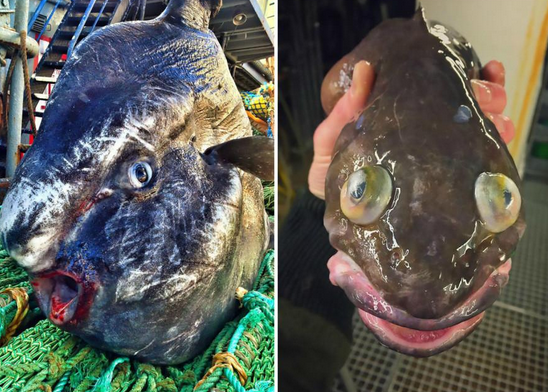Some of these bizarre creatures might look like they're from outer-space but in reality they've been scooped from the deepest, darkest depths of the ocean.
这些怪异的生物看起来好像是来自外太空,但其实他们是来自最黑暗的深海。
The incredible pictures have won scientist Roman Fedortsov a cult online following with hundreds of users competing to identify the other-worldly specimens.
这些奇异的照片帮助科学家罗曼·费多索夫在网上引起了极大轰动,数百名网友争相目睹这些超俗的生物。
Mr Fedortsov regularly shares colourful pictures showing the bizarre creatures he discovers during his research trips.
费多索夫经常会分享一些五颜六色的照片,展示他在研究旅行途中发现的种种怪异生物。

The explorer, from the city of Murmansk in north-western Russia's Oblast region, said that both his father and grandfather were fishermen, so looking for fish runs in the family.
这位探险家来自俄罗斯西北部的摩尔曼斯克州,他表示,自己的父亲和祖父都是渔民,因此他们一家都喜欢寻找鱼类。
And with his current job in charge of fish processing he has 'prime access' to all kinds of marine creatures.
而由于他目前的工作是鱼类加工,因此他总是能接触到各种海洋生物。
Discussing his photographs, he said: 'Followers get an idea that every time we pull up a net it is full of extraordinary fish. In reality it is not true. It happens rarely.'
谈到自己照片时,他说道:“粉丝们认为,每次我们只要撒下网就能捞到许多奇怪的鱼,但是事实并非如此,很少会发生这样的事。”
'The dangerous fish usually live in the deep in the southern seas and the Atlantic Ocean. There is nothing in the northern seas.'
“危险的鱼类通常生活在南部海域和大西洋的深处。北部海域没什么东西。”
Many of the fish discovered are either black or red, which are best to prevent being spotted by larger prey fish in the deep sea.
被发现的许多鱼类要么是黑色,要么是红色,这些颜色在深海里能够最好地避免被猎食者发现。












